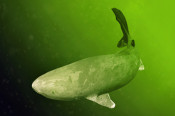We were walking along the Wonderopolis seashore the other day when we overheard an interesting conversation between a beaver and a platypus:
Beaver: Hey Pete! Did you know it's Ollie's birthday today?
Platypus: No way, Ben! You mean Ollie the octopus? We should throw him a surprise birthday party!
Beaver: That's what I was thinking! We should get him a cake and some balloons.
Platypus: OK! You get the cake and I'll get the balloons and candles. How old is Ollie anyway?
Beaver: Um…I don't know. I thought you would know.
Platypus: How would I know? How do you even tell how old an octopus is anyway?
We had errands to run, so we didn't get to hear the end of their conversation. We hope they figured out how many candles to put on Ollie's cake. Their conversation did get us to thinking, though. Exactly how can you tell how old animals are anyway?
After all, it's not like you can just ask them. Give it a try. Ask your dog or cat how old it is. We highly doubt it'll meow or woof a certain number of times to provide you with an answer.
Does it really matter if we know how old animals are? To many scientists, it does indeed matter. When studying animal populations, it's often very important to know as precisely as possible how many animals there are and how old they are.
This information can help scientists to determine which species are thriving and which ones need protection from becoming endangered or extinct. While it's often easy to keep track of a favorite pet's age, determining the age of an animal in the wild can be difficult.
Unfortunately, there's no tried-and-true method that scientists can apply to all animals. What might work for one animal might not work at all for another. Over time, however, scientists have developed several methods that work fairly well for certain animals.
Zoologists, for example, might take X-rays of certain animals to examine their internal skeletal structures. These structures often contain growth markers that can provide an approximate age for the animal.
For many animals, the teeth provide good visual cues that can help experts determine their age. In some species, adult teeth don't come in until a certain age. Additionally, worn down and decayed teeth can point toward advanced age.
Hair, fur, and skin can also provide visual clues about age. Like humans, certain animals tend to get wrinkly skin and gray hair or fur as they get older. If you have an older dog, you may have noticed that its muzzle gets grayer as it gets older.
The eyes and ears might also help age an animal. As animals get older, their hearing often deteriorates. Likewise, their eyesight might begin to fail. Examining a dog's eyes, for example, might reveal cloudiness that can appear at an advanced age.
Marine animals can be particularly hard to age. For example, fish are usually aged based upon examination of tiny ear bones called otoliths. Otoliths contain growth rings similar to those of a tree. Unfortunately, the fish has to be dead to examine these bones! If you have to determine the age of a live fish…well…good luck!
Scientists are continuing to discover new and more advanced ways of determining the age of animals. Recently, scientists learned that they could determine the age of humpback whales by scraping their skin and examining their DNA.
So what about Ollie the octopus? It can indeed be very difficult to determine the age of an octopus. They have no bones, so scientists often guess age based upon size. Unfortunately, body size can vary widely based upon several factors. Fortunately, Mexican researchers recently discovered that the stylet, a harder part of the mantel of the octopus, could be used to guess the age of an octopus with reliability.


.jpg)









Mady
ethan
Ethan
Carmyne B.
Emma
mariana
samantha s
Willa
samantha s
logan paul
camarius
camarius
jake paul
camarius
adrien
adrien
tra
Kaliyah
ayanna
jaca
Felis catus